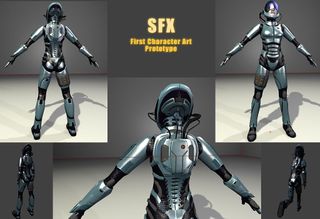It's Mass Effect's 15th birthday so the original pitch document is doing the rounds again
Have a look at what changed, and what stayed the same.

Mass Effect is 15 years old as of November 20, and unofficial Twitter account Mass Effect News has celebrated by collecting together some of its prototype art, video, and documents. While none of this is new (the scan of the 2003 pitch document has been floating around on the internet for over a decade), it's still interesting to look back at how much of it changed.
For starters, when Casey Hudson submitted that pitch on September 15, 2003, it was for a game to be called not Mass Effect, but "SFX". Other suggested titles came later, several of which made it as far as having logos designed, like The Epsilon Effect, Biowar, Element Zero, Element, The Oculon, The Optigon, Unearthed, Nebula: Guardians of the Citadel, Star Citadel, and plain old The Citadel.
One of SFX's main features was to be multiplayer trading, with an entire online economy made possible by Xbox Live in which "you can meet friends online in special locations in the game to chat and trade valuable items in a virtual environment." This would allow players to "create powerful items not available without online trading" and make money via a "dynamic in-game economy". It sounds a bit like EVE Online, or maybe a contemporary live-service game, especially when it gets to additions made possible via regular updates like "new locations, special items, new quests, and online news updates about the best players."
Plenty of what the pitch describes is the same as what we ended up getting, from the basics of the setting to the idea of gameplay that builds on what BioWare did previously with Star Wars: Knights of the Old Republic, only made "more accessible to the mainstream audience." Specifics like having a "small party of 2 or 3, selected from a larger group" and exploring the galaxy via "Jump Gates" that facilitate long-distance travel, while local travel is possible with your ship's on-board FTL drive, were right there from the beginning—with minor differences, some of which would end up being realized in Mass Effect 2. Your starship being upgradeable for one, as well as the ability to switch to other party members in combat.
The early plot outline, from January 8, 2004, likewise has a lot of the basics of the setting down. That said, it does describe Earth as the game's start location, after which your home base would be a space station called "Star City" rather than the Citadel, and from which you'd be able to "establish new jump stations and expand the galactic frontier". The twist you'd learn while searching the galaxy for artifacts belonging to a vanished creator species who left technology behind would be that "Humans were engineered as the slave class of the creator race millennia ago."
The thread also bundles in the first prototype footage of SFX, showing that shooting people behind crates in warehouses was part of Mass Effect from the word go. It also includes a video compiling gameplay trailers from much later in development that include some stuff that was ultimately cut from the first game, like destructible environments, direct control of squad members in combat, and a mission on a mining world called Caleston that would be folded into Liara's rescue mission on Therum—complete with a scene where Shepard uses a renegade interrupt on Garrus in the middle of dialogue.
It's fun to have a look back at how things started while we wait to hear more about where Mass Effect is going next. The latest news on that front came on N7 Day, when BioWare dropped a video with a hidden message encoded in it. Last year, BioWare marked the occasion with a teaser image that said "Mass Effect will continue". At the bottom of that picture was a spaceship that will presumably be ours to fly in the next Mass Effect. And the name stenciled on the side of that ship? "SFX", in honor of the name Mass Effect almost had.
The biggest gaming news, reviews and hardware deals
Keep up to date with the most important stories and the best deals, as picked by the PC Gamer team.

Jody's first computer was a Commodore 64, so he remembers having to use a code wheel to play Pool of Radiance. A former music journalist who interviewed everyone from Giorgio Moroder to Trent Reznor, Jody also co-hosted Australia's first radio show about videogames, Zed Games. He's written for Rock Paper Shotgun, The Big Issue, GamesRadar, Zam, Glixel, Five Out of Ten Magazine, and Playboy.com, whose cheques with the bunny logo made for fun conversations at the bank. Jody's first article for PC Gamer was about the audio of Alien Isolation, published in 2015, and since then he's written about why Silent Hill belongs on PC, why Recettear: An Item Shop's Tale is the best fantasy shopkeeper tycoon game, and how weird Lost Ark can get. Jody edited PC Gamer Indie from 2017 to 2018, and he eventually lived up to his promise to play every Warhammer videogame.
Most Popular






